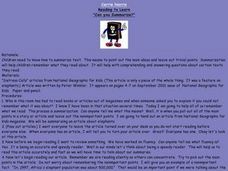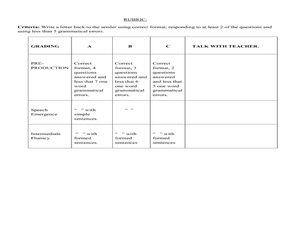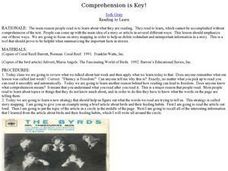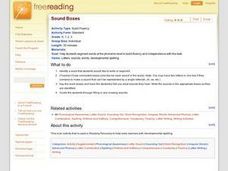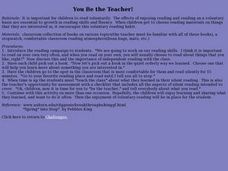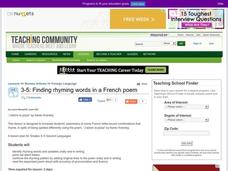Curated OER
Can you Summarize?
Students write summaries of non-fiction articles in this lesson plan. They read the article silently and then pick out the main points. Students list the main events as a whole class activity, and then they individually write a summary...
Curated OER
KWL Chart
Students create a KWL chart on a selected nonfiction topic using a variety of strategies. They infer the answers to four questions, identify a purpose for reading, list four or more things about the topic, and list four or more answers...
Curated OER
Speech Therapy Students Interact Between Schools
Students use technology to improve their communication skills and have the ability to interact with other speech students attending other elementary schools. Through riddles, games, and other activities, students attain their speech...
Curated OER
Write Right Back
Third graders explore communications by utilizing technology. In this e-mail writing activity, 3rd graders identify important elements to include when writing an e-mail based on whether it's to a friend, colleague or employer. Students...
Curated OER
Comprehension is Key!
Young scholars observe and demonstrate how to use a story map to identify the main idea of text. They observe the teacher read an article about birds out loud, and create a story map for the article. Students then independently read...
Curated OER
Let's Summarize!
Students discover the six steps to use when reading to help know what is important. They then listen to the book, Tambourine Moon focusing on the important information and discarding unnecessary or repeating information. They then break...
Curated OER
Sum Stuff
Students are introduced to informational text. Students explore nonfiction as a genre. They identify the components and text structure of text nonfiction. Students read a nonfiction passage and write a summary of the passage.
Curated OER
Vocabulary Activity
In this vocabulary worksheet, learners match definitions to words, unscramble words and use words in sentences to show their meaning. Students then complete a timed reading exercise with the words, 4 sets of 7 words total.
Curated OER
Vocabulary Activity: 2
In this vocabulary instructional activity, students match definitions to words, unscramble words and use words in sentences to show their meaning. Students then complete a timed reading exercise with the words, 4 sets of 7 words total.
Curated OER
Sight Words on a Snowy Evening
Students read various poems by Robert Frost. In groups, they use the text of one poem to identify sight words that are new to them. As a class, they listen to a recording of the poem and then repeating it outloud practicing their...
Curated OER
Guided Writing: Writing a Story on the OHP
Students practice fluency as well as story-writing skills. They work together to prepare and write their stories. Students are told that they are going to write a story entitled 'A Wonderful Day' and that they are going to be the...
Curated OER
Star Summarizers
Students participate in a reading literacy lesson with the goal of improving reading fluency and comprehension. They work on the skill of summarization that helps to pick out important details of a reading.
Curated OER
Nemo's Fast Swim
Students need to be come fluent readers and in order to do that they have to read faster, smoother and more expressively. They have to read accurate and automatic. Students gain fluency through repeated readings, timed readings, and...
Curated OER
Sound Boxes
Students explore language fluency by identifying word segments. In this word structure lesson, students utilize words from their vocabulary lesson, dissect them into syllables and sound out their individual parts. Students participate in...
Curated OER
Haunting of Third Grade
Third graders discuss the meaning of the word "haunted." They watch as the teacher demonstrates using a sticky note to mark words that they find interesting in their reading. Students read chorally, then break into groups for a...
Curated OER
Only Let Your Brain Hear You!
Students explore the benefits of silent reading and practice reading silently in this lesson. As they are silently reading, they use the cross checking strategy to monitor their comprehension. The teacher assesses their progress by...
Curated OER
You Be the Teacher!
Students choose reading materials on things that they are interested in. They discover voluntary reading habit and discuss the importance of independent reading. They "teach the class" about what they learned in their silent reading.
Curated OER
Listen to the Pin Drop
Students practice reading silently. The class discusses the benefits of reading silently and several methods for reading silently, including cross checking and chunking. Working in groups, they silently read a leveled text and discuss...
Curated OER
Punch in the Stomach...uhhh
Students discover that letters and their correspondences will lead to successful decoding, reading fluency, and reading comprehension. They recognize the letter u and the correspondence u=/u/. They repeat the tongue twister with the...
Curated OER
Amazing Animal Alliteration Book
Students understand the meaning of alliteration. In this alliteration lesson plan, students write sentences using alliteration and recognize how it changes the writing in a story.
Curated OER
Finding Rhyming Words in a French Poem
Explore rhyming in this phonemic awareness and French lesson plan. Listen to the poem "J'Adore la Pizza" by Karen Kransky and identify rhyming words. Compare grapheme spelling patterns with like phonemes, and sort word cards according to...
Curated OER
Face to Face Summary!
Students, while in the computer lab visiting the National Geographic Kids website, fill out a checklist of unimportant/redundant information, look for important events and ideas and search for the author's main idea and supporting...
Curated OER
Willie Nelson: All Together Now!
Students recite Willie Nelson's lyrics in one voice and then analyze their tone and vocabulary usage. They research Willie Nelson's history and dramatize the song: "On the Road Again."
Curated OER
Vocabulary Building Activities
In these four building vocabulary worksheets, students view vocabulary word lists, use definition clues, unscramble letters, and write sentences using each vocabulary word. Students write twenty-one answers per activity.
